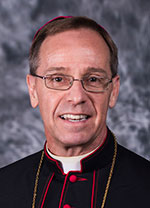Christ the Cornerstone
Seeing and touching Jesus in the fullness of Easter joy

“[Jesus] stood in their midst and said to them, ‘Peace be with you.’ But they were startled and terrified and thought they were seeing a ghost. Then he said to them, ‘Why are you troubled? And why do questions arise in your hearts? Look at my hands and feet, that it is I myself. Touch me and see, because a ghost does not have flesh and bones as you can see I have.’ And as he said this, he showed them his hands and his feet. While they were still incredulous for joy and were amazed, he asked them, ‘Have you anything here to eat?’ They gave him a piece of baked fish; he took it and ate it in front of them”
(Lk 24:36-43).
The Risen Christ is not a ghost. The Gospel reading for the Third Sunday of Easter makes this clear.
Jesus appears to his disciples. “But they were startled and terrified and thought they were seeing a ghost” (Lk 24:37). The Lord reassures them, showing them his hands and his feet. He invites them to “touch me and see, because a ghost does not have flesh and bones as you can see I have” (Lk 24:39).
Going a step further, Jesus asks if they have anything to eat. They give him some fish, which he takes and eats in front of them. This is no ghost. He is a human being like us, St. Luke’s Gospel assures us. And yet we know that this man is different from us. He is sinless, and he is risen from the dead.
Jesus has been without sin from the moment of his conception by the Holy Spirit in the womb of his mother, Mary. Being sinless means that he is perfectly aligned with God’s will. While his human nature may occasionally trouble him with doubt—as during the agony in the garden—he always concludes, “Father, not my will but yours be done.”
After rising from the dead, Jesus retains his human body. His hands and feet, which have retained some semblance of the horrible wounds he suffered on Good Friday, are seen and touched by the disciples. But there is something very different about his appearance. Often the disciples don’t recognize him until he performs some sign, such as the breaking of the bread. Then they are “incredulous for joy” and “amazed.” They can see the risen Lord, and touch his hands and his feet, but they still can’t quite believe that what they are seeing and touching is really him.
For the disciples, this experience of joyful hesitation will change. Once they receive the gift of the Holy Spirit at Pentecost, they will be transformed from cowards hiding behind locked doors to bold witnesses to the Gospel.
As St. Peter proclaims in the reading from the Acts of the Apostles this coming Sunday, “The author of life you put to death, but God raised him from the dead; of this we are witnesses” (Acts 3:15). The timid disciples become evangelists and martyrs once they have been empowered by the Holy Spirit. In spite of the fact that they are no longer able to see Jesus face to face or to touch his hands and his feet, they now know him intimately and freely share this knowledge with others.
How do they know him? According to the first letter of St. John, “The way we may be sure that we know him is to keep his commandments. Whoever says, ‘I know him,’ but does not keep his commandments is a liar, and the truth is not in him. But whoever keeps his word, the love of God is truly perfected in him. This is the way we may know that we are in union with him: whoever claims to abide in him ought to live as he lived ” (1 Jn 2:3–6).
We touch and see Jesus when we keep his word. When we love God, when we love one another in union with Christ, he is present among us.
Jesus has made it clear that whatever we do (or fail to do) to his brothers and sisters, we do (or fail to do) to him. This means that we can see and touch the risen Jesus in those who are poor, who suffer, who are homeless or who live in fear. If we ignore them, we ignore Jesus. If we remain behind locked doors (our comfort zones) like the disciples before Pentecost, we remain “startled and terrified” whenever the Lord presents himself to us.
The risen Christ is no ghost. He is a human being like us. Let’s pray for the courage to recognize Jesus, to reach out and touch him in the fullness of Easter joy. †
